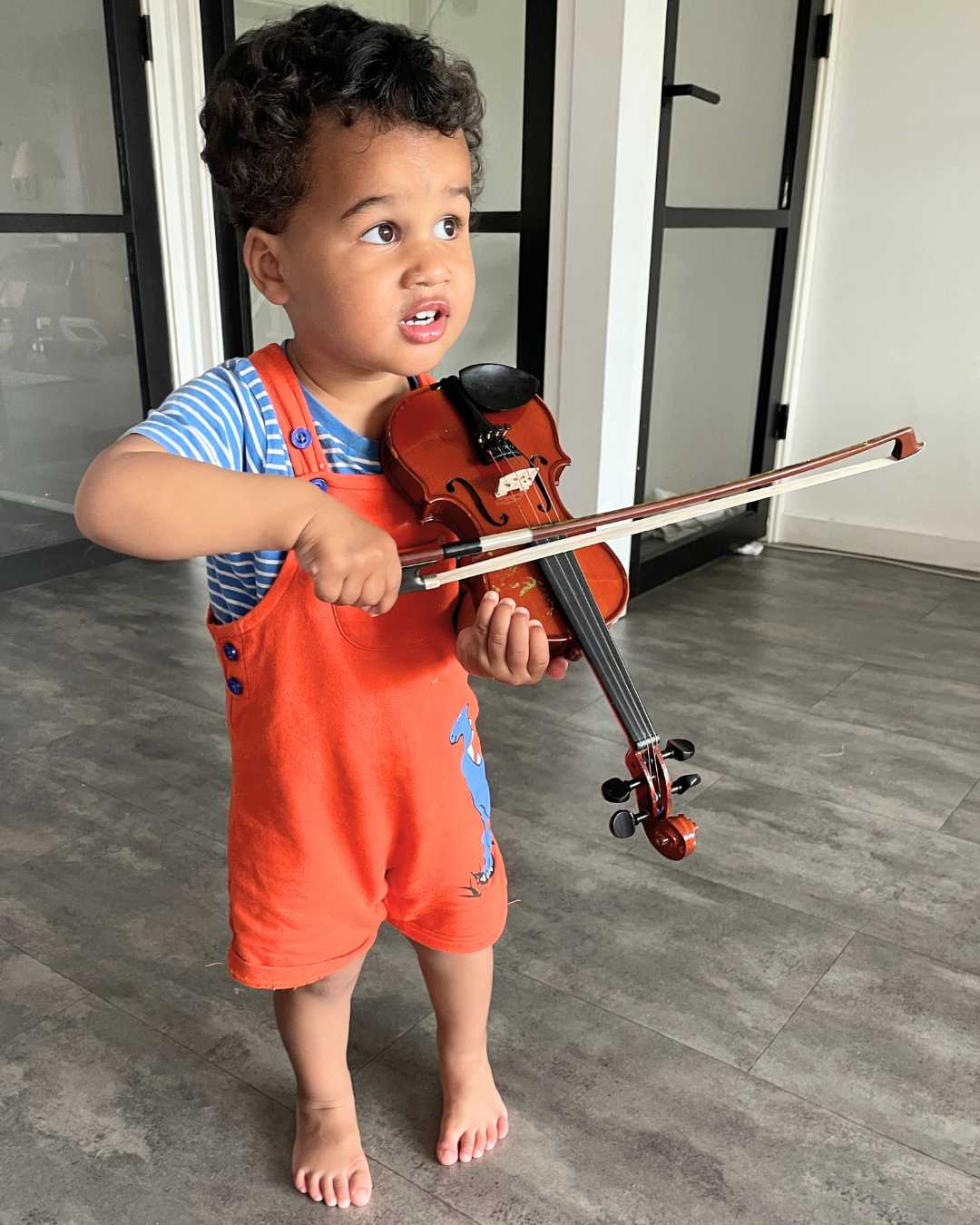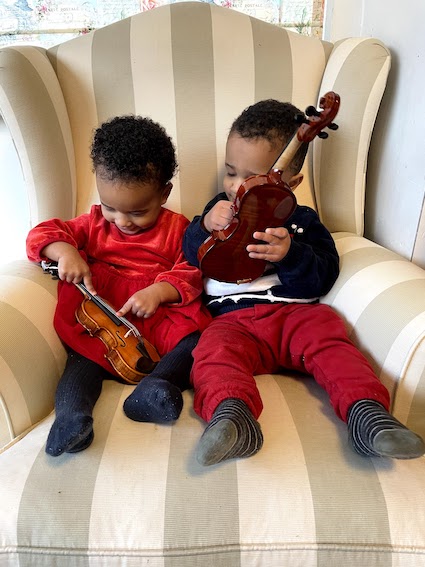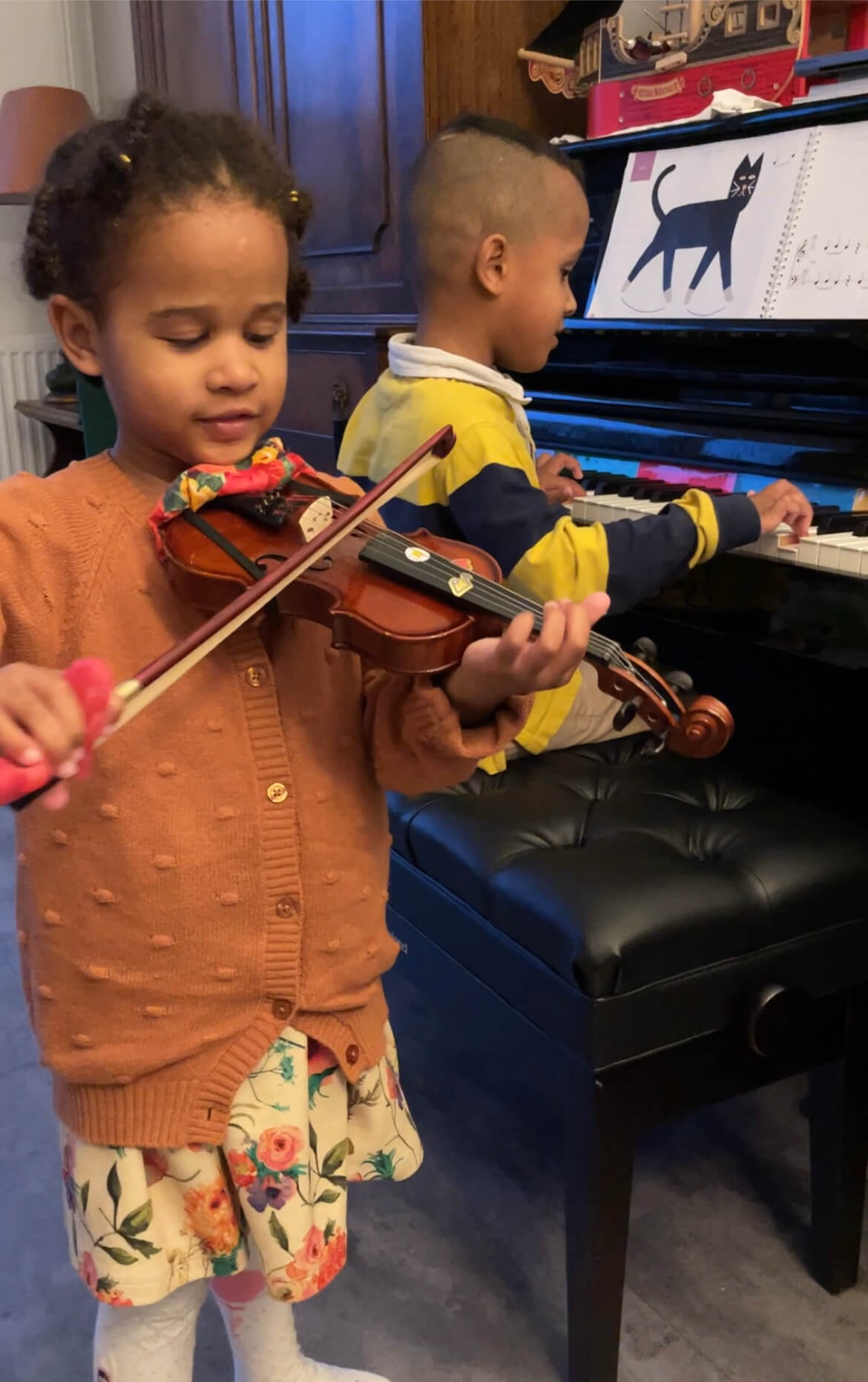What if your toddler doesn’t stick to the violin?
You want to share your own passion for the violin with your child and they are all enthusiastic until… they see a flute, or a piano, or a guitar
We are told to start an instrument as young as possible and you want your child to enjoy music as well.
A violin teacher from Vienna e-mailed me that her son was so enthusiastic about the violin from the early age of just one year old. He took his 1/64 violin everywhere, even to the playground. They just couldn’t be separated.
This was until at two years old he went to a kindergarten event where the teachers played… guitar.
Now he doesn’t want the violin under his chin anymore. He just wants guitar. If he does something with the violin, he plays it like a guitar. ‘I feel playing the violin or at least a bowed instrument is ‘his’, but it doesn’t work anymore’.

How to get your toddler’s motivation back for the violin?
Why was the child so enthusiastic about the violin in the first place? Children love to imitate, which is how they learn, and they love to share in your joy. You play violin and so will your child.
Does this really mean that the violin is their instrument? It can… but it also cannot. Did your son choose the violin, because he likes the timbre or the way of playing better than other instruments? Or is it just because he’s not exposed to other instruments? Or is it just too early to tell?
Bright shiny objects
Every instrument a child sees for the first time is new and exciting. They want to explore how it works and are amazed by this new timbre they hear. The fact that a child wants to explore something at this moment in time, doesn’t tell you anything about what instrument they would play for their whole life. You will see that if he ever sees a trumpet, he will want to play that, and a grand piano etc etc.
It’s all ok to explore those things. Also playing the violin like a guitar… why not? It might just revive his enthusiasm to see that you can also strum a violin.
This is age is all about getting them engaged in music and having joyful experiences
How to bring back the attention to the violin?
Play violin for him. He will want to do it just like you. Or have him hear the difference in sound… that the violin sings beautifully with the bow and that plucking is a bit dull. Let him just soak it in and he might want to get back to the bow.
Also accept that he might not and perhaps the violin isn’t ‘his’ at this point. Sing for him throughout the day. Listen to music together. This age is all about experience and soaking in different tonal and rhythmic patterns.
It could also be a matter of comfort… the violin on the collarbone and against the neck can seem hard. I’ve made a soft cushion myself that covers the chinrest, the brackets and underneath the violin (no shoulder rest), so the violin is nice and soft to cuddle and inviting to place against the neck. My daughter never wanted the violin against her neck until I discovered that the brackets of the chinrest were too hard. A Tido pad or something is a done-for-you option.
What I’m loving for violin for young kids is Stringosaurus resources, which is fun, but also teaches them great basic technique and develops musicianship.
At this age building musicianship might be most important no matter what instrument they’ll pick
At two years old the fine motor skills might not be very much developed yet, but you can develop inner hearing anytime. This will ‘pay off’ much more in the future, whatever instrument he picks.
As a violin player you probably know that no muscle memory can compensate for not knowing if you’re in tune or how a note should sound.
Learn to teach music as a teacher, parent or carer
As a violin teacher we quickly move to teaching the mechanics of our instrument, while for this age it makes much more sense to teach music. Even if they choose to learn violin in the future, this will go much faster.
I’ve used the book Music Play (and done a teacher training for it at GIML) which is based on the music learning theory by Gordon. In the books there are games and the children learn different keys and modes, tonal and rhythmic patterns. I like to mix this method in, but I was missing some connection to familiar melodies that speak to the child’s imagination and culture. This is what brought me to Kodaly.
At the moment I’m doing a Colour Strings kindergarten teacher training online, that is excellent if you want to teach young ones. The great thing is that it’s based on Kodály, so good to build musicianship and train their ears. The songs match the songs in the ColourStrings violin method (and the same methods for flute, piano and guitar), so you can use them side by side.
You can also see if there are Kodály inspired early childhood classes near you (or other early childhood music classes). Being in a class with a teacher and fellow toddlers can be lots of fun.
Sing to your child
When you can sing it, you can play it. You can learn the mechanics of an instrument, but won’t get far if your ear isn’t developed.
Combine singing with movement. Children learn with their whole bodies. Think of rocking, swaying, tapping, walking, stomping, jumping and bouncing. This teaches the pulse and steady beat of the music. You can also use Orff percussion instruments. A simple shaker is already lots of fun. Scarves are also excellent as you can move more in flow with them
Look for songs that teach:
- different ranges (from a second to an octave)
- high and low (pitch)
- fast and slow
- loud and soft
- different rhythmic patterns
- different keys: major, minor, pentatonic, maybe modes like dorian or locrian

Don’t worry too much about it
Two years old is still very young and the pleasure in music is crushed all too easily. I was taking it too seriously in the past, while kids just want to play and go back and forth instruments.
With singing and movement, you can develop their musicianship. My twins have just started school and it already stands out to the teachers that they’re having so much fun when the class sings and they have a good singing voice. Also they learn new songs very quickly, because they’ve been exposed to so many different tonal and rhythmic patterns from the womb to where they are now.
Lots of kids learn mainly ‘Are you sleeping’ and ‘Twinkle twinkle’, which are excellent songs, but if you’re learning the same melodies with different texts, you are mainly developing speech. Listen to different kinds of music together and teach your child lots of different songs.
My 4 year old twins (in the picture 16 months old with their first violins) are just now getting a bit more serious in terms of daily practicing and choosing an instrument.
How my own kids chose their instruments
My twins got their first violins at 16 months and in between our general music learning, they’ve played them back and forth.
Louise stills enjoys playing the violin. Now she’s four she’s playing almost each day and we’re in Colourstrings book B. We started out with lots of harmonics and left hand pizzicato to teach a good left hand set up and intonation (harmonics can’t be out of tune). She doesn’t have stickers on the fingerboard and she hears when something is out of tune.
It’s all still extremely playful and she can’t focus for long, so our practice sessions are very short. However we do spend lots of time singing, with text and with solfa and Kodaly hand signs.
She does have a piano accompanist already though… her brother Victor was mesmerized when I bought a real piano for in our living room. He hasn’t touched his violin since and is very serious about learning. He says he wants to be a pianist when he grows up. I started him on the Kodaly based piano method ColourKeys.
My kids now have the same songs in the Singing Rascals books (Colourstrings kindergarten music lessons) as they have in their violin and piano books. They already know the songs they are about to play on their instruments. For us this is a combination that works very well.
What works for you?
Share in the comments how you’ve introduced your little ones to music and also feel free to ask questions.


0 Comments